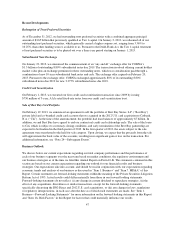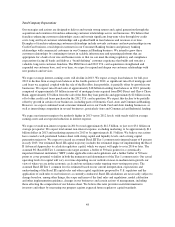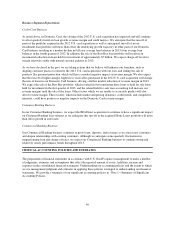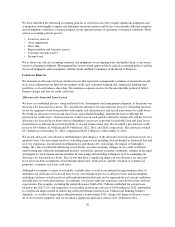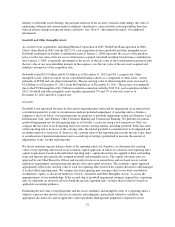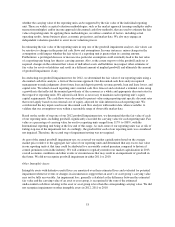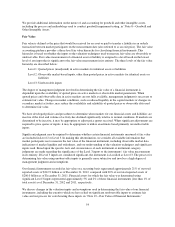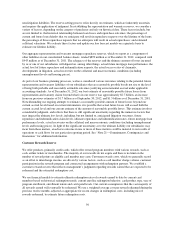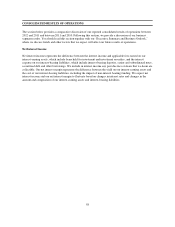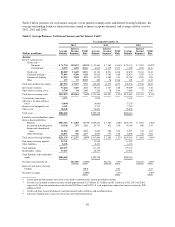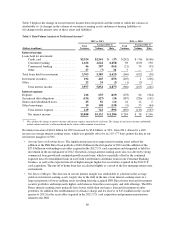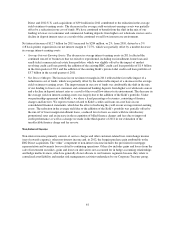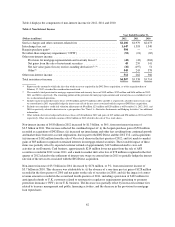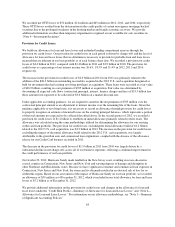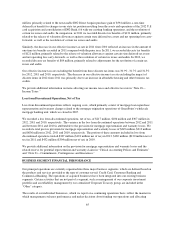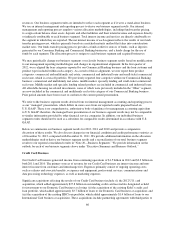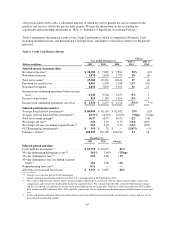Capital One 2012 Annual Report Download - page 76
Download and view the complete annual report
Please find page 76 of the 2012 Capital One annual report below. You can navigate through the pages in the report by either clicking on the pages listed below, or by using the keyword search tool below to find specific information within the annual report.
We continually evaluate our reserve methodology and assumptions based on developments in redemption
patterns, cost per point redeemed, contract changes and other factors. Changes in the ultimate redemption rate
and weighted-average cost per point have the effect of either increasing or decreasing the reserve through the
current period provision by an amount estimated to cover the cost of all points previously earned but not yet
redeemed by card members as of the end of the reporting period. We recognized customer rewards expense of
$1.3 billion, $1.0 billion and $760 million in 2012, 2011 and 2010, respectively. Our customer rewards liability,
which is included in other liabilities in our consolidated balance sheets, totaled $2.1 billion and $1.7 billion as of
December 31, 2012 and 2011, respectively.
Income Taxes
Our annual provision for income tax expense is based on our income, statutory tax rates and other provisions of
tax law applicable to us in the various jurisdictions in which we operate. Tax laws are complex and subject to
different interpretations by the taxpayer and respective governmental taxing authorities. Significant judgment,
including evaluating uncertainties, is required in determining our tax positions and calculating our tax expense.
We review our tax positions quarterly and adjust the balances as new information becomes available.
Our income tax expense consists of two components: current and deferred taxes. Our current income tax expense
approximates taxes to be paid or refunded for the current period. It also includes income tax expense related to
our uncertain tax positions and revisions of our estimate of accrued income taxes resulting from the resolution of
income tax controversies. Our deferred income tax expense results from changes in our deferred tax assets and
liabilities between periods.
Deferred tax assets and liabilities represent decreases or increases in taxes expected to be paid in the future
because of future reversals of temporary differences between the financial reporting and tax bases of assets and
liabilities, as well as from net operating loss and tax credit carryforwards. Deferred tax assets are recognized
subject to management’s judgment that realization is “more likely than not.” We evaluate the recoverability of
these future tax deductions by assessing the adequacy of expected taxable income from all sources, including
taxable income in carryback years, reversal of taxable temporary differences, forecasted operating earnings and
available tax planning strategies. These sources of income rely heavily on estimates. We use our historical
experience and our short- and long-range business forecasts to provide insight.
We had deferred tax assets, net of deferred tax liabilities and valuation allowances, of $2.9 billion as of
December 31, 2012, compared with $2.3 billion at December 31, 2011. We had a valuation allowance of $123
million and $89 million as of December 31, 2012 and 2011, respectively. We expect to fully realize in future
periods the net deferred tax asset of $2.9 billion recorded as of December 31, 2012. If changes in circumstances
lead us to change our judgment about our ability to realize deferred tax assets in future years, we will adjust our
valuation allowances in the period that our change in judgment occurs and record a corresponding increase or
charge to income.
We provide additional information on income taxes in “Consolidated Results of Operations” and in “Note 18—
Income Taxes.”
ACCOUNTING CHANGES AND DEVELOPMENTS
See “Note 1—Summary of Significant Accounting Policies” for information on accounting standards adopted in
2012, as well as recently issued accounting standards not yet required to be adopted and the expected impact of
these changes in accounting standards. To the extent we believe the adoption of new accounting standards has
had or will have a material impact on our results of operations, financial condition or liquidity, we discuss the
impacts in the applicable sections(s) of MD&A.
57


